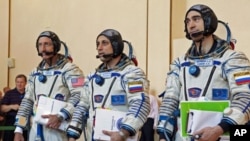The failure of a Russian Soyuz cargo rocket several minutes after launch last month, and Russia's decision to suspend all Soyuz launches while it investigates the cause, has created some problems for International Space Station partners. NASA officials are discussing the possibility of leaving the station unmanned for the first time in nearly 11 years, as partner countries discuss the readiness to resume Russian Soyuz launches to the station.
Speaking to reporters earlier this week from aboard the space station, NASA astronaut Mike Fossum said the station's six crew members are not yet preparing to leave the orbiting lab unmanned. He said, though, that officials at NASA's Johnson Space Center in Texas are considering their options.
"The teams in Houston are in the preliminary stages of deciding everything from what ventilation we're going to leave running, what lights we are going to leave on, what condition each particular experiment will be on - every tank, every valve, every hatch," said Fossum. "There is a lot to do, and they are just beginning that work right now. It is too early for us to get too worried about that, frankly."
Challenges leaving ISS unmanned
If you have ever had to leave your house empty for a few weeks or months, you have probably made a similar checklist. You make sure all the doors and windows are closed properly. Maybe you adjust the thermostat and the main water or radiator valves, or you unplug appliances that do not need to be powered up. And, for added peace of mind, perhaps you leave keys with a trusted neighbor who can check in on your place. No such luck for space station astronauts.
While Fossum said it is premature to worry about leaving the space station unoccupied, he acknowledges that it could happen for the first time since 2000. And, if it happens, astronauts would not be able to do an in-person transfer to the next crew.
"It is possible we will have a station without people on it for a hopefully short period of time. Those plans, we have not started anything specific up here pertaining to that, expect for maybe documenting some of the things that we do on video so that we can use video products for part of the training for the next crew," said Fossum. "We'll be getting into the details of what it takes to turn out the lights in the weeks ahead."
Considering various scenarios
The first part of the station was launched in 1999, and people have lived continuously on it since November 2000. Fossum says that prolonged presence is not only a source of pride, but important to ensuring the proper functioning of the station.
Fossum pointed out that if something breaks without someone on hand to fix it, such as another cooling pump failure, it could trigger other issues, and the risks increase the longer the space station is left unoccupied.
Three of the six members of the station's crew will leave the ISS on September 15. In mid-November, Astronaut Fossum and two crew members from Japan and Russia are set to return to Earth. They will use the two Soyuz vehicles docked at the space station.
NASA said the schedule to launch three new crew members is under review while the U.S. space agency and its international partners assess the readiness to resume Soyuz launches.
In the meantime, NASA said the station is in a good configuration, and there are plenty of supplies to support the present crew.









